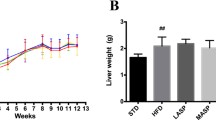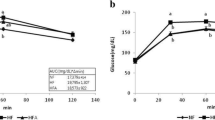Abstract
Super CitriMax (HCA-SX) is a novel calcium/potassium salt of (−)-hydroxycitric acid extracted from the dried fruit rind of the plant Garcinia cambogia, and commonly consumed as weight loss dietary supplement. In the present study, we investigated the effect of HCA-SX on inflammation, oxidative stress and insulin resistance in developing obese Zucker rats, an animal model of type II diabetes associated with inflammation and oxidative stress. Male Zucker rats (5-week old) were supplemented with vehicle (control) and HCA-SX in drinking water for 7 weeks. Oxidative stress markers, including malondialdehyde (MDA), protein carbonyl (DNPH), and protein tyrosine nitration (tyr-NO2) were measured in the liver and kidney tissues using biochemical and immunoblotting techniques. Compared to controls, the levels of MDA, DNPH and tyr-NO2 were lower in the liver and kidney of HCA-SX-treated animals. Furthermore, the levels of C-reactive protein and interleukin-6, markers of inflammation measured by ELISA, were lower in the plasma of HCA-SX-supplemented animals compared to controls, as were levels of fasting plasma insulin, glucose, and triglycerides. Interestingly, insulin resistance did not develop in HCA-SX-supplemented rats. Food-intake and body weight gain was also lower in rats supplemented with HCA-SX compared to their control counterparts. These results suggest that HCA-SX supplementation in obese Zucker rats reduces food-intake, body weight gain, and also attenuates the increases in inflammation, oxidative stress, and insulin resistance observed in untreated animals. Therefore, HCA-SX may be used as an intervention to overcome obesity-related complications, including inflammation, oxidative stress, and insulin resistance.





Similar content being viewed by others
References
Jebb SA (1999) The Nutrition Society Medical Lecture. Obesity from molecules to man. Proc Nutr Soc 58:1–14
Nakamura T, Tokunaga K, Shimomura I, Nishida M, Yoshida S, Kotani K, Islam AH, Keno Y, Kobatake T, Nagai Y, Fujioka S, Tarui S, Matuzawa Y (1994) Contribution of visceral fat accumulation to the development of coronary artery disease in non-obese men. Atherosclerosis 107:239–246
Behn A, Ur E (2006) The obesity epidemic and its cardiovascular consequences. Curr Opin Cardiol 21:353–360
Chander PN, Gealekman O, Brodsky SV, Elitok S, Tojo A, Crabtree M, Gross SS, Goligorsky MS (2004) Nephropathy in Zucker diabetic fat rat is associated with oxidative and nitrosative stress: prevention by chronic therapy with a peroxynitrite scavenger ebselen. J Am Soc Nephrol 15:2391–2403
Xu ZG, Lanting L, Vaziri ND, Li Z, Sepassi L, Rodriguez-Iturbe B, Natarajan R (2005) Upregulation of angiotensin II type 1 receptor, inflammatory mediators, and enzymes of arachidonate metabolism in obese Zucker rat kidney: reversal by angiotensin II type 1 receptor blockade. Circulation 111:1962–1969
Dahlman I, Forsgren M, Sjogren A, Nordstrom EA, Kaaman M, Naslund E, Attersand A, Arner P (2006) Downregulation of electron transport chain genes in visceral adipose tissue in type 2 diabetes independent of obesity and possibly involving tumor necrosis factor-{alpha}. Diabetes 55:1792–1799
Uysal KT, Wiesbrock SM, Marino MW, Hotamisligil GS (1997) Protection from obesity-induced insulin resistance in mice lacking TNF-alpha function. Nature 389:610–614
Sarafidis PA, Ruilope LM (2006). Insulin resistance, hyperinsulinemia, and renal injury: mechanisms and implications. Am J Nephrol 26:232–244
Talpur N, Echard BW, Yasmin T, Bagchi D, Preuss HG (2003) Effects of niacin-bound chromium, Maitake mushroom fraction SX and (−)-hydroxycitric acid on the metabolic syndrome in aged diabetic Zucker fatty rats. Mol Cell Biochem 252:369–377
Saengsirisuwan V, Perez FR, Sloniger JA, Maier T, Henriksen EJ (2004) Interactions of exercise training and alpha-lipoic acid on insulin signaling in skeletal muscle of obese Zucker rats. Am J Physiol Endocrinol Metab 287:E529–E536
Banday AA, Marwaha A, Tallam LS, Lokhandwala MF (2005) Tempol reduces oxidative stress, improves insulin sensitivity, decreases renal dopamine D1 receptor hyperphosphorylation, and restores D1 receptor-G-protein coupling and function in obese Zucker rats. Diabetes 54:2219–2226
Soni MG, Burdock GA, Preuss HG, Stohs SJ, Ohia SE, Bagchi D (2004) Safety assessment of (−)-hydroxycitric acid and Super CitriMax, a novel calcium/potassium salt. Food Chem Toxicol 42:1513–1529
Jena BS, Jayaprakasha GK, Singh RP, Sakariah KK (2002) Chemistry and biochemistry of (−)-hydroxycitric acid from Garcinia. J Agric Food Chem 50:10–22
Ramos RR, Saenz JL, Aguilar CF (1995) Extract of Garcinia cambogia in the control of obesity. Invest Med Int 22:97–100
Shimomura I, Tokunaga K, Jiao S, Funahashi T, Keno Y, Kobatake T, Kotani K, Suzuki H, Yamamoto T, Tarui S, Matuzawa Y (1992) Marked enhancement of acyl-CoA synthetase activity and mRNA, paralleled to lipoprotein lipase mRNA, in adipose tissues of Zucker obese rats (fa/fa). Biochim Biophys Acta 1124:112–118
Pikavance LC, Tadayyon M, Widdowson PS, Buckingham RE, Wilding JPH (1999) Therapeutic index for rosiglitazone in dietary obese rats: separation of efficacy and haemodilution. Brit J Pharmacol 128:1570–1576
Buege JA, Aust SD (1978) Microsomal lipid peroxidation. Methods Enzymol 52:302–310
Schacter E, Williams JA, Lim M, Levine RL (1994) Differential susceptibility of plasma proteins to oxidative modification. Examination by Western blot immunoassay. Free Radic Biol Med 17:429–437
Koo JR, Vaziri ND (2003) Effects of diabetes, insulin and antioxidants on NO synthase abundance and NO interaction with reactive oxygen species. Kidney Int 63:195–201
Schaap LA, Pluijm SM, Deeg DJ, Visser M (2006) Inflammatory markers and loss of muscle mass (sarcopenia) and strength. Am J Med 119:526.e9–526.e17
Asghar M, Zeyssig R, Monjok E, Kouamou G, Ohia SE, Lokhandwala MF, Bagchi D (2006) Hydroxycitric acid (HCA-SX) decreases oxidative stress and insulin resistance and increases brain serotonin levels in obese Zucker rats. Exp Biol Meeting 20:A655.4
Mauri MC, Rudelli R, Somaschini E, Roncoroni L, Papa R, Mantero M, Longhini M, Penati G (1996) Neurobiological and psychopharmacological basis in the therapy of bulimia and anorexia. Prog Neuropsychopharmacol Biol Psychiatry 20:207–240
Widdowson PS, Upton R, Henderson L, Buckingham R, Wilson S, Williams G (1997) Reciprocal regional changes in brain NPY receptor density during dietary restriction and dietary-induced obesity in the rat. Brain Res 774:1–10
Curzon G, Gibson EL, Oluyomi AO (1997) Appetite suppression by commonly used drugs depends on 5-HT receptors but not on 5-HT availability. Trends Pharmacol Sci 18:21–25
Williams G, Bing C, Cai XJ, Harrold JA, King PJ, Liu XH (2001) The hypothalamus and the control of energy homeostasis: different circuits, different purposes. Physiol Behav 74:683–701
Gertow K, Rosell M, Sjogren P, Eriksson P, Vessby B, de Faire U, Hamsten A, Hellenius ML, Fisher RM (2006) Fatty acid handling protein expression in adipose tissue, fatty acid composition of adipose tissue and serum, and markers of insulin resistance. Eur J Clin Nutr 60:1406–1413
Asghar M, Lokhandwala MF (2006) Antioxidant tempol lowers age-related increase in insulin resistance in Fischer 344 rats. Clin Exp Hypertens 28:533–541
Petersen AM, Pedersen BK (2005) The anti-inflammatory effect of exercise. J Appl Physiol 98:1154–1162
Halse R, Pearson SL, McCormack JG, Yeaman SJ, Taylor R (2001) Effects of tumor necrosis factor-alpha on insulin action in cultured human muscle cells. Diabetes 50:1102–1109
Youd JM, Rattigan S, Clark MG (2000) Acute impairment of insulin-mediated capillary recruitment and glucose uptake in rat skeletal muscle in vivo by TNF-alpha. Diabetes 49:1904–1909
Saghizadeh M, Ong JM, Garvey WT, Henry RR, Kern PA (1996) The expression of TNF alpha by human muscle. Relationship to insulin resistance. J Clin Invest 97:1111–1116
Mishima Y, Kuyama A, Tada A, Takahashi K, Ishioka T, Kibata M (2001) Relationship between serum tumor necrosis factor-alpha and insulin resistance in obese men with Type 2 diabetes mellitus. Diabetes Res Clin Pract 52:119–123
Hotamisligil GS (1999) Mechanisms of TNF-alpha-induced insulin resistance. Exp Clin Endocrinol Diabetes 107:119–125
Giugliano D, Ceriello A, Paolisso G (1996) Oxidative stress and diabetic vascular complications. Diabetes Care 19:257–267
Nitenberg A, Cosson E, Pham I (2006) Postprandial endothelial dysfunction: role of glucose, lipids and insulin. Diabetes Metab 32:S28–S33
Ugochukwu NH, Figgers CL (2007) Dietary caloric restriction improves the redox status at the onset of diabetes in hepatocytes of streptozotocin-induced diabetic rats. Chem Biol Interact 165:45–53
Author information
Authors and Affiliations
Corresponding author
Rights and permissions
About this article
Cite this article
Asghar, M., Monjok, E., Kouamou, G. et al. Super CitriMax (HCA-SX) attenuates increases in oxidative stress, inflammation, insulin resistance, and body weight in developing obese Zucker rats. Mol Cell Biochem 304, 93–99 (2007). https://doi.org/10.1007/s11010-007-9489-3
Received:
Accepted:
Published:
Issue Date:
DOI: https://doi.org/10.1007/s11010-007-9489-3




